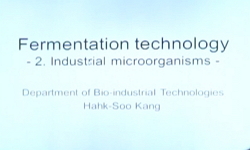Background: Some differences have been reported in the biotransformation of ginsenosides, probably due to the types of materials used such as ginseng, enzymes, and microorganisms. Moreover, most microorganisms used for transforming ginsenosides do not...
http://chineseinput.net/에서 pinyin(병음)방식으로 중국어를 변환할 수 있습니다.
변환된 중국어를 복사하여 사용하시면 됩니다.
- 中文 을 입력하시려면 zhongwen을 입력하시고 space를누르시면됩니다.
- 北京 을 입력하시려면 beijing을 입력하시고 space를 누르시면 됩니다.
https://www.riss.kr/link?id=A103834244
- 저자
- 발행기관
- 학술지명
- 권호사항
-
발행연도
2017
-
작성언어
English
- 주제어
-
등재정보
SCIE,SCOPUS,KCI등재
-
자료형태
학술저널
- 발행기관 URL
-
수록면
36-42(7쪽)
- 제공처
-
0
상세조회 -
0
다운로드
부가정보
다국어 초록 (Multilingual Abstract)
Background: Some differences have been reported in the biotransformation of ginsenosides, probably due to the types of materials used such as ginseng, enzymes, and microorganisms. Moreover, most microorganisms used for transforming ginsenosides do not meet food-grade standards. We investigated the statistical conversion rate of major ginsenosides in ginsenosides model culture during fermentation by lactic acid bacteria (LAB) to estimate possible pathways. Methods: Ginsenosides standard mix was used as a model culture to facilitate clear identification of the metabolic changes. Changes in eight ginsenosides (Rb1, Rb2, Rc, Rd, Re, Rf, Rg1, and Rg2) during fermentation with six strains of LAB were investigated. Results: In most cases, the residual ginsenoside level decreased by 5.9-36.8% compared with the initial ginsenoside level. Ginsenosides Rb1, Rb2, Rc, and Re continuously decreased during fermentation. By contrast, Rd was maintained or slightly increased after 1 d of fermentation. Rg1 and Rg2 reached their lowest values after 1-2 d of fermentation, and then began to increase gradually. The conversion of Rd, Rg1, and Rg2 into smaller deglycosylated forms was more rapid than that of Rd from Rb1, Rb2, and Rc, as well as that of Rg1 and Rg2 from Re during the first 2 d of fermentation with LAB. Conclusion: Ginsenosides Rb1, Rb2, Rc, and Re continuously decreased, whereas ginsenosides Rd, Rg1, and Rg2 increased after 1-2 d of fermentation. This study may provide new insights into the metabolism of ginsenosides and can clarify the metabolic changes in ginsenosides biotransformed by LAB.
동일학술지(권/호) 다른 논문
-
- The Korean Society of Ginseng
- Oh, Mi-Jeong
- 2017
- SCIE,SCOPUS,KCI등재
-
- The Korean Society of Ginseng
- Shen, Wenwen
- 2017
- SCIE,SCOPUS,KCI등재
-
- The Korean Society of Ginseng
- Cui, Shaoqing
- 2017
- SCIE,SCOPUS,KCI등재
-
Animal lectins: potential receptors for ginseng polysaccharides
- The Korean Society of Ginseng
- Loh, So Hee
- 2017
- SCIE,SCOPUS,KCI등재








 DBpia
DBpia



